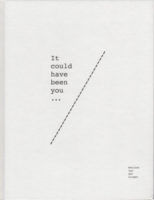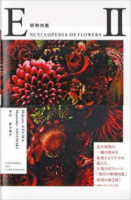
We live in an age in which technology is our salvation. We’re focused on data, and we believe that anything that works with data will make our lives better (whatever evidence to the contrary there might be notwithstanding), will provide relief from the vast uncertainty that is life. The more there is at stake, the more data are seen as what will make the difference, that somehow there will come meaning out of numbers or graphs, whether it’s the stock market, or numbers resulting from medical tests.
We attach the same importance to photographs as well (and there now is ample talk that digital cameras deliver not just pictures, but – somehow – data). Photographs, we think, give us vital clues about the world, in particular if they’re portraits. If they’re portraits, they show us not just the surface of the portrayed person’s skin, they give us a window into her or his soul.
These ideas come together in Reinier van der Lingen‘s It could have been you if it hadn’t been me. The book contains a larger portrait of Babet Boon, covering the period of a little over two years while she was fighting breast cancer. Combining portraits of the woman’s face with medical data, taken at regular intervals, the book traces a life in limbo. Only medical professionals, and possibly those with experience dealing with cancer, will understand the relevance of the acronyms, medical terms, and numbers. But we all will be able to see something in Boon’s changing face.
Smartly designed by Sybren Kuiper, the book resembles a clinical report. And all those overwhelmed by the flood of data might just want to go from the portrait taken on 2 February 2012 to the one on 15 May 2013 to get some idea of the kind of experience Babet Boon must have had.
It could have been you if it hadn’t been me; photographs by Reinier van der Lingen; 152 pages; Komma/d’jonge Hond; 2014
Rating: Photography 3, Book Concept 3, Edit 3, Production 4 – Overall 3.3

Right after the internet, book fairs are possibly the absolute worst possible places to look at photobooks, especially if they are very large. The way I usually approach them is to do repeated visits, going back and back and back, to be able to get beyond what strikes me right away and to then look for what I might have overlooked. This approach will not guarantee I get to see every book. But it does make sure that I end up looking at books I didn’t consider picking up once, twice, three times…
At Unseen 2015, this approach had me pick up Makoto Azuma & Shunsuke Shiinoki‘s Encyclopedia of Flowers II at the very end of what I thought was really just a final, somewhat bored walk across the photobook market that I had visited four of five times before. What happens next I remember very well. It doesn’t happen very often that looking at a photobook causes the kind of reaction I experienced that late afternoon. I gasped. And then I scrambled to get my wallet out.
This particular book is an unlikely candidate for anyone from the world of art photography to get excited about. Certainly, most people I told about the book didn’t appear to get excited at all, only to then experience the same reaction I had when looking at it. Strictly speaking, Encyclopedia of Flowers II is a sort of encyclopedia, given that there is ample information about each and every one of the various flowers used in the arrangements photographs of which can be found inside.
But it really is one the most visceral experiences with photography I have come across in a long time. Open the book anywhere, and your eye will be overwhelmed by a massive assault of colour. This is no minimalist ikebana flower arranging. These are vast groups of flowers, carefully put together, yet designed to overwhelm. Whether it is shades of red or green or white, or combinations of colours, their abundance engulfs the viewer. If there ever was a pornography of colour, here is one (and I mean that in the best possible sense).
Utterly brilliant.
Encyclopedia of Flowers II; flower arrangements by Makoto Azuma; photographs by Shunsuke Shiinoki; 544 pages; Seigensha Art Publishing; 2015
Rating: Photography 5, Book Concept 4, Edit 3, Production 5 – Overall 4.5
Ratings explained here.
